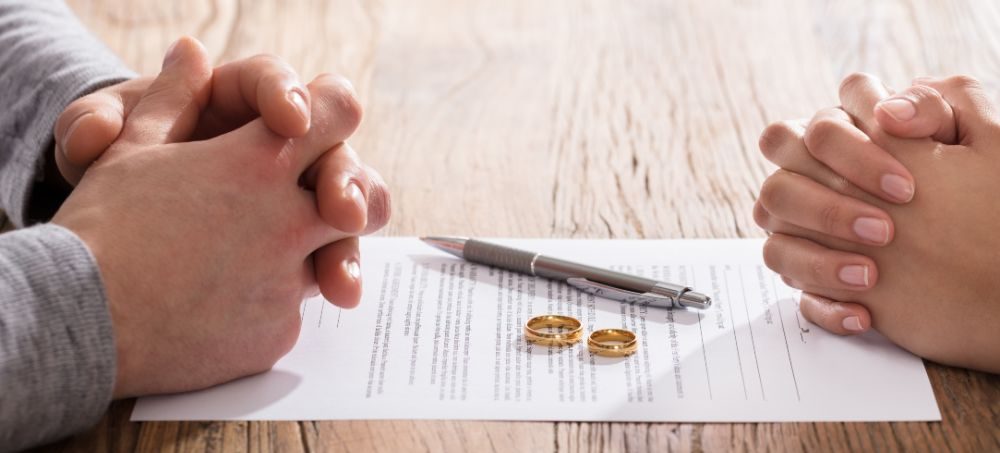Unfortunately, not every marriage lasts forever. If you are in need of a quick divorce, you are most likely searching the internet for information on paperwork, division of property, spousal support, and child custody. If all the details of the process have left you feeling overwhelmed, know that you do not have to face it alone. Having an experienced California divorce lawyer on your side can help you understand how to get a quick divorce in California.
While a divorce can take time, there are ways to speed up the process. An uncontested divorce is the quickest end to a marriage partnership in the state of California. For a divorce to be uncontested, all parties must agree on the conditions of the divorce, including division of property, spousal support, and child custody.
An uncontested divorce can be completed in as little as six months. Every situation is different, though, and your California divorce lawyer will walk you through the process to ensure you take the right course of action for your divorce.
What Is the Process of an Uncontested Divorce in California?
Before you can start the process of a divorce in California, you or your spouse must meet residency requirements. This means that either you or your spouse has been a resident of the state of California for at least six months before you file. Also, either you or your spouse must have lived in the county in which you are filing for at least three months.
Since California holds to a no-fault divorce system, you will not have to meet certain grounds or prove wrongdoing by your spouse to be granted a divorce. When you are ready to file, there are a few steps you will need to follow.
- Step One: File a Divorce Petition. You cannot file for divorce without submitting the necessary paperwork. You will need to submit a Form FL-100, Petition for Dissolution, and Form LF-110, Summons, to your local court. If you have children with your spouse, there may be additional paperwork for you to file.
- Step Two: Serve the Divorce Papers. This is something you can do on your own, or you may have someone else do it for you as long as they are 18 years or older. Whoever is serving your spouse the papers will need to file a Form FL-115, Proof of Service of Summons. It is important to confirm that your spouse receives these documents to file their response.
- Step Three: File a Response. Your spouse must file a response to these papers within a 30-day window. If they do not respond, the court could issue a default judgment. Your divorce will be officially filed by the court once you have served the papers and your spouse has responded, or either of you files an Appearance, Stipulation, and Waver.
- Step Four: Submit a Settlement Agreement. If both parties approve of the divorce settlement terms, you may submit a signed settlement agreement. Completing this settlement quickly helps to keep the process as short as possible. A California divorce lawyer can help you settle these terms in as little time as possible.
- Step Five: The Waiting Period. The state of California has a six-month waiting period for a divorce to be complete. This waiting period starts on the date the divorce papers are filed. If both parties agree to move forward with the divorce by the end of the six-month period, the process reaches the final stage.
- Step Six: Final Judgement and Termination. The court reviews the settlement agreement once the six-month waiting period is over. If the agreement is approved, you will enter the final judgment of the divorce. This judgment is issued by the court and outlines the division of assets, custody agreements, and any other terms deemed necessary.
While an amicable divorce where both parties come to a reasonable agreement on the terms of the divorce is ideal, this is not always the case. Because of this, the judgment of the court can be issued through two other processes:
- If your spouse does not respond within the allotted time after you serve them divorce papers, the court may issue a default judgment.
- If both parties are not able to successfully negotiate the terms of the divorce settlement, the court may issue judgment at the conclusion of a trial.
You have options when it comes to resolving your divorce. While it can be difficult for divorcing spouses to reach a mutual agreement on some subjects, it is almost always worth exploring alternative dispute resolution like mediation whenever possible. If you are wondering how long your divorce will take, alternative dispute resolution could reduce the total timeline of your case significantly.
If you’re wondering what could slow down your divorce, the list of potential complications you could face is quite long. Failure to submit a complete and accurate financial disclosure, attempting to hide assets from property division, refusal to accept a divorce petition, disputes over child custody, and arguments involving child support and/or spousal support are just a few of the most commonly cited delays divorcing couples encounter in California.
It’s crucial to hire a divorce lawyer who can provide personalized legal counsel. While every divorce case in California must comply with relevant statutes and address the same topics, every case is also unique. Your attorney should be able to provide individualized counsel and address each element of your divorce. They can also help you understand all of the options available for resolving your specific divorce case in California.
Understanding Summary Dissolution in California
Some divorcing couples in California can qualify for a summary dissolution, which is a streamlined divorce outlined in California Family Code Sections 2400 to 2406. To qualify, the couple must have been divorced for less than five years and have no children. They must also have limited marital assets and debts and have no real property in joint ownership.
The spouses seeking summary dissolution must also supply a waiver of spousal support and a signed agreement for property division. They file the petition for summary dissolution jointly. If the court approves the summary dissolution, they must still wait the mandatory six months before they receive a finalized divorce order.
If you meet the qualifications for summary dissolution, it is important to hire a divorce lawyer who can help you take full advantage of the benefits of this process. Your attorney can assist with gathering all the financial records and other documentation you will need to submit along with your joint petition and help draft the signed agreements and waivers you will need to submit to the court.
When To Hire a Divorce Lawyer for Your California Case
Even in uncontested divorce cases, legal challenges can arise that require experienced legal guidance. If you want to avoid costly mistakes or delays, it may be time to hire a divorce lawyer who understands the court process and the nuances of California divorce laws.
Any mistakes you make in paperwork, missed deadlines, or misunderstandings about property division can derail an otherwise simple case. An attorney’s insight can make a measurable difference in how your case resolves. Almost every divorce case is contested to some extent, but complex financial issues are often inherently difficult to resolve and can significantly extend the timeline for resolving the divorce.
In 2022, California’s divorce rate stood at 17.77 per 1,000 married women. Women also head around 80% of single-parent homes in California and across the country. Whether you’re ending a short-term marriage under the five-year rule or navigating a more complex financial and custody situation, a lawyer’s experience helps ensure your rights are protected from the start.
As a general rule, it’s a good idea to hire a divorce lawyer as soon as you have made the decision to divorce, or as soon as your spouse has served you with divorce papers. Resolving the various financial elements of divorce can be confusing without an attorney’s help, and accuracy is crucial. A good attorney can handle gathering all of the documentation you will need for your case and assist you with meeting all applicable procedural deadlines.
Why Legal Support Is Worth It. Even for Uncontested Divorces
Many people turn to online forms and self-help resources in an attempt to manage their divorce on their own. While these tools may be useful for some, they don’t provide the tailored advice that may be needed to address unique family dynamics, business ownership, real estate issues, or child custody plans. Even a minor oversight can cause major complications.
Hiring a divorce attorney can help you draft a clear and enforceable settlement agreement, which prevents ambiguity and future disputes. If you and your spouse have a shared mortgage, a blended family, or even retirement assets to divide, an attorney can help you work through those details thoroughly. The Orange County Child Support Services 2023–24 report showed that 6,340 child support cases were opened during FFY2024, a reminder of how many cases lead couples to search for ways to efficiently end their marriages.
Attorneys also know the local legal landscape. If you’re filing in Orange County, for instance, your documents might be processed through the Lamoreaux Justice Center in Orange (341 The City Drive South), while someone in Los Angeles County may need to attend hearings at the Stanley Mosk Courthouse (111 N Hill St, Los Angeles). Local familiarity with these courts can help avoid delays caused by procedural errors or overlooked filing requirements.
What to Expect in Alternative Dispute Resolution
Many divorcing couples in California and throughout the United States are pursuing alternative dispute resolution, such as mediation and collaborative divorce, to resolve their dissolution proceedings rather than heading straight into litigation. While alternative dispute resolution is not always a viable option, whenever both spouses agree to try it, they can potentially save a great deal of time and money on their divorce. They can also have more control over the outcome.
When you hire a divorce lawyer in California, they can determine whether it would be in your interest to pursue any type of alternative dispute resolution. Many couples are able to resolve some elements of divorce this way and then proceed with resolving remaining issues in litigation. Your attorney can explain the options for alternative dispute resolution available to you and the potential advantages of each option.
Ensuring a Smoother Path to Divorce Finalization
The six-month waiting period in California can feel like a long time, especially when both spouses are ready to move on. However, working with a California divorce lawyer during this time can help you make the most out of that time.
Your attorney can ensure that all required disclosures are made and help you comply with court deadlines. They can also finalize any agreements that may still need refinement. Their involvement can reduce the stress you are under and provide reassurance that no legal details are being missed. They will also help you resolve any unexpected complications that might arise, helping you streamline your divorce proceedings as much as possible.
Uncontested divorces are often straightforward, but legal complications can arise from any marriage, even among amicable ex-spouses. From managing court requirements to ensuring compliance with California divorce laws, an experienced legal advocate is essential for keeping your divorce on track so you can prepare for the next chapter of your life with confidence.
Let a knowledgeable attorney help you avoid unnecessary stress and finalize your divorce efficiently. If you’re ready to move forward, now is the time to hire a divorce lawyer who can protect your future. The attorneys at Quinn & Dworakowski, LLP, have extensive experience handling all types of divorce cases in California, and we’re confident we can help you reach a positive conclusion to your case. Reach out to us today to learn more about the legal services we offer for divorce.
FAQs
Q: What Is the Quickest Way To Get a Divorce in California?
A: The quickest and least expensive way to get a divorce in California is to have an uncontested divorce. This means that both parties are amicable and able to reach a reasonable agreement on the terms of the divorce. The process can take much longer if one or both parties are unwilling to come to an agreement.
Q: How Fast Is an Uncontested Divorce in California?
A: An uncontested divorce in California can take as little as six months from the date the divorce petition is filed with the court. Once you have filed the petition, you will then serve the papers to your spouse. They will file a response, and you will both submit your settlement agreement. Once this is done, you will enter the waiting period. At the end of this period, the court will issue a judgment and termination.
Q: Can You Get a Divorce Faster Than 6 Months in California?
A: California has a six-month waiting period rule, and because of this, it takes a minimum of six months for a divorce to be official. This waiting period begins on the day you file the petition for divorce in court. Once this period is over and the court has issued final judgments and granted termination, you will be legally divorced.
Q: What Is the 5-Year Rule for Divorce in California?
A: If a divorce case remains unresolved for five years in California, the case will expire, and the divorce will not become legal. This can happen when the parties involved fail to come to an agreement on the settlement terms of the divorce. It can also be caused by one party contesting the divorce. If the case expires, you will need to start the process from the beginning.
Having a California Divorce Lawyer Can Simplify Your Divorce
We understand that there are numerous steps, forms, and requirements for divorce in California. This can make seeking a divorce seem daunting, especially if your forms are not submitted correctly or on time. Our attorneys at Quinn & Dworakowski, LLP, are here to help you. We will work hard to ensure the process of your divorce goes as smoothly as possible. If you are ready to take the first step in your divorce, contact us today to see how we can help.






